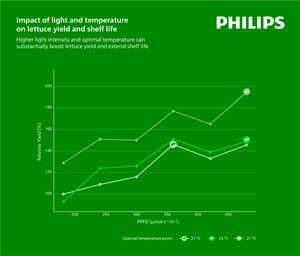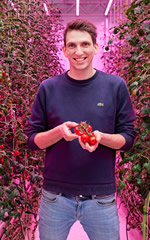Crispy lettuce: achieving yield, quality, and longer shelf-life in vertical farms
At the Philips GrowWise Research Center, we explored how light and temperature strategies can help crispy lettuce deliver on all fronts: higher yields, better quality, and longer shelf-life. Our trials with modern cultivars such as Crismina, Finstar, and Hydrolique showed that today’s crispy lettuce can handle higher light levels and warmer temperatures without tip burn, doubling yields compared to low-light, cool conditions, and extending the shelf-life. The results highlight how growers can strike the right balance to make crispy lettuce both productive and reliable in vertical farms.
Stronger cultivars for indoor growing
.jpeg) The demand for convenient, ready-to-eat lettuce is growing fast. To meet this, many growers are switching to shorter crop cycles, higher planting densities, and baby leaf–style harvests. While this creates opportunities, crispy lettuce was often seen as challenging due to its sensitivity to tip burn and uneven quality.
The demand for convenient, ready-to-eat lettuce is growing fast. To meet this, many growers are switching to shorter crop cycles, higher planting densities, and baby leaf–style harvests. While this creates opportunities, crispy lettuce was often seen as challenging due to its sensitivity to tip burn and uneven quality.
New breeding efforts have changed that. Modern crispy lettuce types are much more tolerant to higher light and more resistant to tip burn. This means growers can now push crops harder indoors to achieve higher yields without sacrificing quality.
Light and temperature in balance
We tested six different light levels (ranging from 180 to 480 μmol·s⁻¹·m⁻²) and three temperature settings (21 to 27 °C) to see how plants respond to different balances of light and heat, also known as the Radiation-Temperature Ratio (RTR). RTR describes the balance between available light energy and ambient temperature, indicating how efficiently plants can use light for growth.
When light intensity is high but temperature is low (resulting in a high RTR), plants photosynthesize more sugars than can be utilized for growth due to limited metabolic and developmental activity. These extra sugars may be stored as starch or turned into compounds like antioxidants, which can improve shelf-life and protect plants from stress. On the other hand, when light is low but temperature is high (a low RTR), plants grow faster than sugars can be produced. This makes growth more efficient in the short term but can leave plants with fewer reserves, making them weaker and reducing shelf-life. Finding the right RTR is therefore key to producing crops that are both high-yielding and high-quality, with better taste, nutrition, and storage life.
Our results showed strong yield improvements:
- Up to 50% higher yield by increasing light intensity at the same temperature
- Up to 33% higher yield by raising the temperature at the same light level
- A doubling of yield when both factors were optimized compared to the lowest settings (180 μmol·s⁻¹·m⁻² at 21 °C).

We also found that higher light consistently increased sugar levels in the leaves, but the effect of temperature on sugars was less predictable. While shelf-life did not always follow sugar content directly, it lasted at least 13 days under all tested conditions. These results suggest that with the right balance of light and temperature, it is possible to achieve both higher yields and more reliable supply chains, with lettuce that stays fresher and tastes better for longer.
Turning insights into results
At the Philips GrowWise Research Center, we’ve shown that with the right cultivars and Philips horticulture intelligent lighting strategies, crispy lettuce can move from a challenging crop to a profitable one. By combining optimal light and temperature conditions, growers can double yields, improve quality, and achieve longer shelf life. Philips horticulture intelligent lighting gives you the tools to fine-tune these conditions, making sure your growing strategy works in your vertical farming setup.

Jarno Mooren is a Plant Specialist at Signify. He is located at the GrowWise Research Center in Eindhoven. His work focuses on setting up and carrying out trials aimed at developing growth recipes that growers can use to efficiently grow crops with desired specifications. He carries out research on light, cropping systems, climate, and nutrients for a wide range of crops for indoor farming.
Comments (0)
This post does not have any comments. Be the first to leave a comment below.
Featured Product

